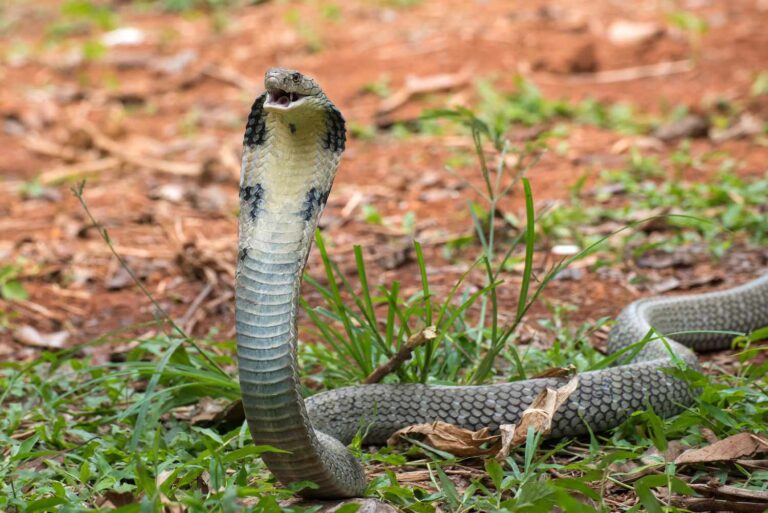Snakes are fascinating creatures that come in all shapes and sizes. Here is a list of the top 10 snakes in the world.
Don’t miss to checkout: Top 10 Cutest Animals in the World
List of the Top 10 Snakes in the World
Explore our list of the top 10 snakes in the world, picked up by our editorial team. Feel free to share the one you love the most.
1. King Cobra
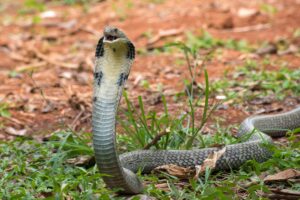
The King Cobra, also known as Ophiophagus Hannah, is one of the most majestic and feared snakes in the world. With its striking appearance and deadly venom, this serpent commands respect wherever it is found in the wild.
Native to the forests of Southeast Asia, the King Cobra is the longest venomous snake in existence, with lengths reaching up to 18 feet. Its iconic hood, which expands when threatened, adds to its menacing presence. This snake’s coloration can range from olive green to black, with lighter bands running along its body, providing camouflage in its natural habitat.
The King Cobra is a skilled predator, preying mainly on other snakes, including pythons and smaller venomous species. Using its exceptional sense of smell and heat-sensing pits, it can locate its prey with ease. Once a target is identified, the King Cobra strikes swiftly and injects a potent cocktail of neurotoxins through its fangs, causing paralysis and eventual death.
Despite its fearsome reputation, the King Cobra is actually a shy and reclusive species, preferring to avoid confrontation with humans. However, if threatened or cornered, it will not hesitate to strike in defense. Due to its lethal venom and size, a bite from a King Cobra can be fatal if not treated promptly.
Conservation efforts are crucial to ensuring the survival of the King Cobra, as habitat loss and poaching threaten its populations in the wild. Many countries where this species is found have implemented protection measures to safeguard its future. Additionally, research is ongoing to study the behavior and biology of these magnificent creatures, providing valuable insights into their ecology and conservation needs.
Despite its reputation as a formidable predator, the King Cobra plays a vital role in the ecosystem as a top-level predator, controlling populations of smaller animals and maintaining balance in its habitat. Its presence symbolizes the delicate interconnectedness of species in the natural world.
In conclusion, the King Cobra is a fascinating and enigmatic creature that deserves our admiration and respect. Its beauty, intelligence, and lethal capabilities make it a true marvel of the animal kingdom. As we continue to learn more about this magnificent snake, let us work together to ensure its survival for generations to come.
2. Black Mamba
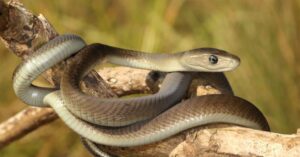
The Black Mamba is one of the most feared and deadly snakes in Africa. Known for its agility, speed, and potent venom, this snake is not to be underestimated. With a reputation for being one of the fastest snakes in the world, the Black Mamba can reach speeds of up to 12 miles per hour, making it a formidable predator in its natural habitat.
Typically found in sub-Saharan Africa, the Black Mamba is primarily active during the day and prefers to hunt and feed during the early morning or late afternoon. With its striking black coloration and sleek body, this snake is easily recognizable in the wild. In fact, the Black Mamba derives its name not from the color of its scales, but from the inside of its mouth, which is dark and inky black.
One of the most dangerous features of the black mamba is its venom. A single bite from this snake can deliver a lethal dose of neurotoxins and cardiotoxins, which can quickly paralyze the victim’s respiratory system and lead to death within hours if left untreated. Due to the potency of its venom, the Black Mamba is responsible for a high number of snakebite fatalities in Africa each year.
Despite its fearsome reputation, the Black Mamba is not inherently aggressive towards humans and will typically only attack if it feels threatened or cornered. However, due to its speed and quick reflexes, encounters with this snake can escalate rapidly if not handled with caution. It is essential to give the Black Mamba a wide berth and respect its space when encountered in the wild.
Conservation efforts are currently underway to protect the Black Mamba and ensure its survival in the wild. Habitat loss, human encroachment, and illegal poaching are all significant threats to the population of these snakes, which are vital to the balance of the African ecosystem. By raising awareness about the importance of these apex predators and implementing measures to protect their natural habitats, we can help ensure the long-term survival of the Black Mamba and other species in Africa.
3. Reticulated Python
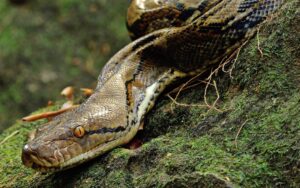
The Reticulated Python (Python reticulatus) is a species of snake that is native to Southeast Asia. It is one of the largest snake species in the world, with some individuals exceeding 20 feet in length. The Reticulated Python is a constrictor, meaning that it kills its prey by squeezing it with its strong coils until it suffocates.
One of the most distinctive features of the Reticulated Python is its beautiful patterned scales. These snakes have a complex network of diamond-shaped scales with intricate patterns of blacks, browns, and yellows. This unique coloration provides excellent camouflage for the snake in its natural habitat of tropical rainforests and marshes.
Reticulated Pythons are highly skilled hunters and are known to prey on a wide variety of animals, including mammals, birds, and even other reptiles. They are ambush predators, relying on their excellent camouflage to surprise their prey and deliver a quick and lethal strike.
Despite their large size and intimidating appearance, Reticulated Pythons are actually quite shy and non-aggressive towards humans. They are solitary animals that prefer to avoid contact with people whenever possible. However, when threatened or cornered, they will not hesitate to defend themselves using their sharp teeth and powerful coils.
In recent years, the Reticulated Python has become a popular pet among reptile enthusiasts. However, potential owners should be aware of the challenges associated with caring for such a large and potentially dangerous animal. Reticulated Pythons require a large enclosure with plenty of hiding spots and climbing opportunities. They also need a varied diet of appropriately sized prey, as well as regular health check-ups from a qualified reptile veterinarian.
In the wild, the Reticulated Python faces numerous threats to its survival, including habitat destruction, poaching for its skin and meat, and human persecution out of fear. Conservation efforts are underway to protect this magnificent species and ensure its continued existence in the wild.
4. Eastern Diamondback Rattlesnake
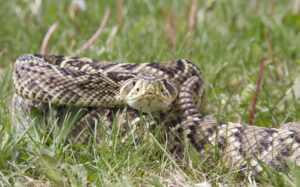
The Eastern Diamondback Rattlesnake, scientifically known as Crotalus adamanteus, is the largest venomous snake in North America. This iconic species is known for its distinctive diamond-shaped markings along its back, hence the name “diamondback.” With its intimidating size and potent venom, the Eastern Diamondback Rattlesnake commands respect and fear in equal measure.
Found primarily in the southeastern United States, the Eastern Diamondback Rattlesnake inhabits a variety of habitats, from pine forests and marshlands to coastal dunes and grassy plains. This adaptable snake is an ambush predator, relying on its excellent camouflage and heat-sensing pits to locate prey such as rodents, birds, and other small animals. When threatened, the Eastern Diamondback Rattlesnake will warn potential predators with its signature rattling sound, giving ample opportunity for humans and animals alike to back away slowly.
Measuring up to 8 feet in length and weighing as much as 15 pounds, the Eastern Diamondback Rattlesnake is a formidable predator with powerful venom. Its hemotoxic venom attacks the victim’s blood cells, causing tissue damage and potentially leading to paralysis or even death if left untreated. Despite their fearsome reputation, Eastern Diamondback Rattlesnakes typically avoid confrontations with humans and will only strike if provoked or cornered.
Conservation efforts are crucial for the survival of the Eastern Diamondback Rattlesnake, as habitat loss and human encroachment pose significant threats to their populations. This species plays a vital role in maintaining the balance of its ecosystem by controlling rodent populations and serving as prey for larger predators. As such, conservationists and wildlife enthusiasts alike strive to protect these snakes and their natural habitats through habitat preservation, education, and responsible wildlife management practices.
5. Inland Taipan
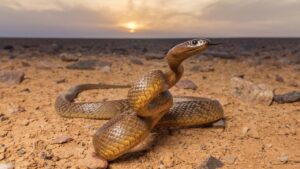
The Inland Taipan, also known as the “fierce snake,” is considered one of the most deadly snakes in the world. This highly venomous reptile is native to the arid regions of central Australia and is considered a top predator in its habitat.
The Inland Taipan’s venom is at least 50 times more toxic than that of the Indian cobra’s. Despite its potent venom, the Inland Taipan is a relatively shy and reclusive snake, preferring to avoid confrontation with humans whenever possible. However, if provoked or threatened, it will not hesitate to deliver a series of rapid and accurate strikes, injecting its venom into its prey.
The primary diet of the Inland Taipan consists of small mammals, particularly rodents such as mice and rats. With its exceptional agility and lightning-fast reflexes, the snake is able to deliver a quick and fatal bite to its prey. Its venom acts swiftly, paralyzing the victim’s nervous system and causing respiratory failure within minutes.
Due to its remote habitat and elusive nature, encounters with the Inland Taipan are rare. However, it is crucial for those living in or traveling to central Australia to be aware of the presence of this deadly serpent and to exercise caution when exploring the outback.
Inland Taipans play a vital role in maintaining the balance of their ecosystem by controlling the population of rodents in their habitat. Despite their fearsome reputation, these snakes are a crucial part of the natural world and should be respected and protected.
Conservation efforts are essential to ensuring the survival of the Inland Taipan and its habitat. Habitat loss, climate change, and illegal collection for the exotic pet trade are major threats to the population of these snakes. By raising awareness about the importance of preserving their natural habitat and implementing protective measures, we can help ensure the continued existence of this remarkable species.
6. Green Anaconda
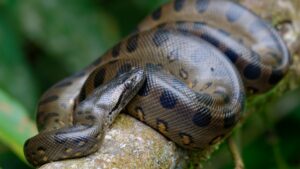
The Green Anaconda, also known as Eunectes murinus, is one of the largest and most powerful snakes in the world. Native to the tropical rainforests of South America, this massive serpent can grow up to 30 feet in length and weigh over 500 pounds. With its incredible size and strength, the Green Anaconda has earned a fearsome reputation as a top predator in its natural habitat.
These creatures, with their sleek bodies and powerful muscles, move effortlessly through rivers, swamps, and marshes, well-adapted to life in the water Their sharp teeth and constricting coils make them formidable hunters, capable of overpowering prey such as fish, birds, and even large mammals like capybaras and deer. Green Anacondas are ambush predators, lying in wait for their unsuspecting victims before launching a sudden and deadly attack.
Despite their fearsome reputation, Green Anacondas are actually quite shy and elusive animals. They are most active at night, when they hunt for food under the cover of darkness. During the day, they often rest in the water or bask in the sun to regulate their body temperature. These snakes are solitary creatures, only coming together during the breeding season when males compete for the attention of females.
One of the most fascinating aspects of the Green Anaconda is its reproductive behavior. Like all constrictor snakes, females give birth to live young rather than laying eggs. A single female can produce a litter of up to 40 baby snakes, each measuring around two feet in length. These tiny anacondas are fully independent from birth and must fend for themselves from the moment they enter the world.
Despite their size and strength, green anacondas are facing threats from habitat loss and human encroachment. Deforestation and development in their native range have led to a decline in their numbers, making them vulnerable to extinction. Conservation efforts are underway to protect these magnificent creatures and ensure their survival for future generations.
7. Coastal Taipan
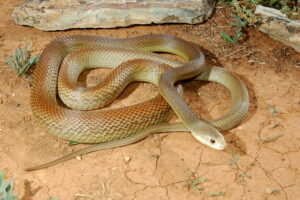
The Coastal Taipan, also known as the “Fierce Snake,” is one of the most dangerous snakes found in Australia. With its potent venom and quick movements, the Coastal Taipan is a fearsome predator that commands respect in its natural habitat.
This highly venomous snake can grow up to 6.6 feet in length and has a slender body covered in smooth scales that range in color from olive-brown to light gray. The head of the creature is elongated and bears large, dark eyes and sharp, fang-like teeth, which it uses to inject venom into its prey.
The Coastal Taipan is a diurnal hunter, meaning it is most active during the day. It preys on small mammals, birds, and reptiles, using its excellent sense of smell and heat-sensing pits to locate its next meal. Once it has located its prey, the Coastal Taipan strikes quickly, injecting a potent neurotoxin that quickly immobilizes its victim.
The venom of the Coastal Taipan is extremely potent and can cause paralysis, respiratory failure, and death in a matter of hours if left untreated. However, despite its deadly venom, the Coastal Taipan is a relatively shy and elusive snake that will often try to avoid confrontation with humans.
Encounters with the Coastal Taipan in the wild are rare, as they typically inhabit remote and uninhabited areas along the coast of northern Australia. However, if you do happen to come across one, it is important to give this snake a wide berth and not attempt to handle or provoke it in any way.
Conservation efforts are in place to protect the Coastal Taipan and its natural habitat, as loss of habitat and human encroachment have posed significant threats to its survival. By educating the public about the importance of these snakes in the ecosystem and the dangers they pose, we can help ensure the continued existence of this important species.
8. Boomslang
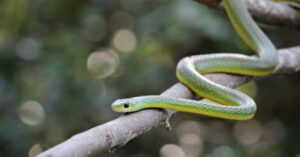
The Boomslang, also known as Dispholidus typus, is a highly venomous snake native to sub-Saharan Africa. With its striking green coloration and slender body, this serpent is both beautiful and deadly. Its name, which means “tree snake” in Afrikaans, is fitting as the Boomslang is often found in trees, where it hunts for its prey.
One of the key characteristics of boomslang is its potent venom. The snake’s venom is highly hemotoxic, meaning that it affects the blood’s ability to clot. This can lead to internal bleeding, organ damage, and even death if left untreated. Despite its deadly venom, Boomslang is generally shy and non-aggressive towards humans. It will usually only strike if threatened or cornered.
Boomslang’s diet consists mainly of birds and bird eggs, although it will also eat small mammals and reptiles. Using its impressive eyesight and stealthy movements, the snake will silently stalk its prey before delivering a quick and lethal bite. Due to its slender body and excellent climbing abilities, the Boomslang is able to navigate through the treetops with ease, making it a formidable hunter.
Although the Boomslang’s venom is deadly, there is an antivenom available that can effectively treat a bite from this snake. However, due to the snake’s relatively non-aggressive nature, bites are rare, and fatalities are even rarer. When encountering a wild animal, especially a potentially dangerous one like the boomslang, exercise caution is essential.
In addition to its venomous bite, the Boomslang also has another unique feature that sets it apart from other snakes: its large, bulging eyes. These eyes provide the snake with excellent vision and depth perception, allowing it to accurately pinpoint and strike at its prey. The boomslang’s eyes are a testament to its hunting prowess and adaptation to its arboreal lifestyle.
9. Cape Cobra
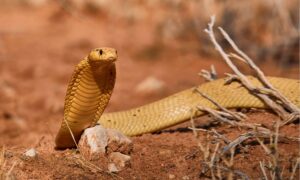
In the southern regions of Africa, the Cape Cobra, also known as the yellow cobra or the Cape coral snake, is a highly venomous snake species that can be found. Known for its striking yellow coloration and highly potent venom, the Cape Cobra is a fearsome predator that commands respect in its habitat.
This species displays distinctive coloring, ranging from pale yellow to vibrant golden hues, with some individuals exhibiting dark brown or black coloration. The Cape Cobra’s coloring serves as both a warning to potential predators and a means of camouflage in its natural environment, allowing it to blend in seamlessly with its surroundings.
One of the most distinctive features of the Cape Cobra is its potent venom, which is neurotoxic in nature and can cause paralysis and respiratory failure in its prey. Despite its deadly venom, the Cape Cobra is not an aggressive species and will generally only strike when threatened or provoked. A Cape Cobra, with its quick reflexes and lightning-fast strikes, can pose a danger and should be avoided whenever possible.
In the event of a bite from a Cape Cobra, immediate medical attention is crucial, as the venom can cause severe symptoms and even death if left untreated. Antivenom is available for treating Cape Cobra bites, but prompt administration is essential for a successful outcome.
Conservation efforts are underway to protect the Cape Cobra and its natural habitats, as the species faces threats from habitat loss, human encroachment, and the illegal wildlife trade. By raising awareness about the importance of preserving this iconic species and its role in maintaining ecological balance, we can ensure that future generations will have the opportunity to admire the beauty and power of the Cape Cobra in the wild.
10. Tiger Snake
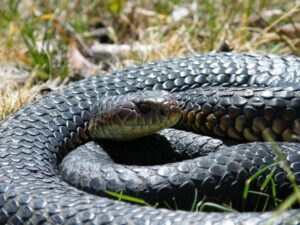
The Tiger Snake (Notechis scutatus) is a highly venomous snake species native to the southern regions of Australia. The name of this animal derives from the distinct dark stripes running across its body, resembling those of a tiger. A tiger snake, with its alluring appearance, is a dangerous creature, as its venom can be lethal to humans.
One of the key characteristics of the Tiger Snake is its variable coloration, ranging from olive-green to yellow, with dark brown or black stripes. This adaptation allows the snake to camouflage effectively in its natural habitat of wetlands, coastal regions, and grasslands. The Tiger Snake is also a proficient swimmer, often found near bodies of water where it preys on fish, frogs, and small mammals.
The venom of the Tiger Snake is a potent cocktail of neurotoxins, myotoxins, and coagulants, which can cause paralysis, muscle damage, and internal bleeding in its victims. Despite their dangerous reputation, tiger snakes are typically reclusive and will only strike if provoked or threatened. If humans encounter venomous snakes, failure to administer the proper antivenom promptly can result in fatal consequences.
Active voice: We focus on preserving the Tiger Snake’s natural habitats and reducing human-wildlife conflicts for its conservation. The introduction of invasive species and habitat destruction pose significant threats to the survival of the species, even though it is not currently endangered. By raising awareness about the importance of protecting these vital ecosystems, conservationists hope to ensure the long-term viability of the Tiger Snake population.


